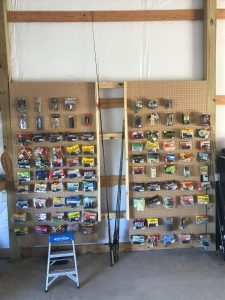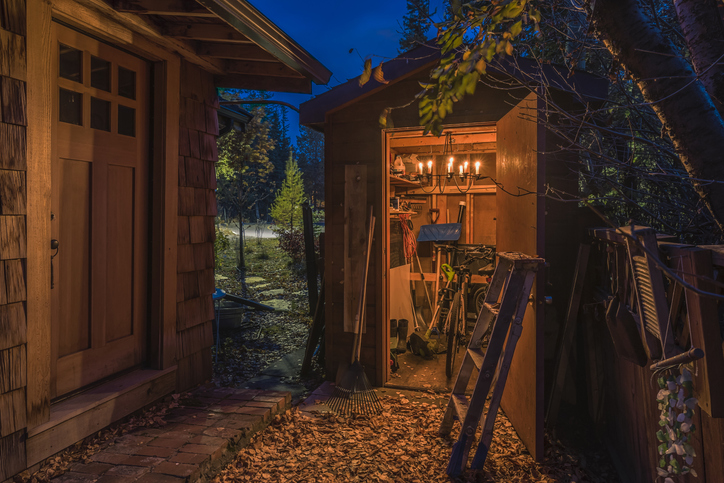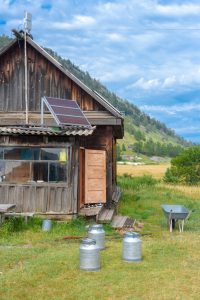Do you love spending time outdoors fishing? If so, you know that it can be a lot of fun but also a bit challenging to keep all of your equipment organized and accessible. A great solution for this problem is to use a shed to store your outdoor fishing gear. We have collaborated with Fair Dinkum Builds to come up with ten tips for using a shed to store your outdoor fishing equipment. So whether you’re a beginner or an experienced angler, read on for some great ideas.
1. Find The Right Size Shed
Pick the right size when choosing a shed to store your fishing equipment. You don’t want a shed that’s too small and cramped, as this will make it difficult to move around and find what you need. Instead, you need to consider the types of fishing rods, and how you would like to store your gear.
For example, fly fisherman often have 9 foot + long rods. And if you’d like to be able to store a rod without breaking it down, you need to size your shed such that a rod can be hung up or leaned against a wall.
Additionally, if you need to store a drift boat or other watercraft, you need to consider size for this as well.
2. Good Location

When deciding where to put your shed, make sure to choose a location that’s close to your house. This way, you won’t have to walk far when you need to get your equipment. Additionally, it’s also a good idea to choose a spot that’s level and has good drainage. It will help keep your shed dry and prevent water damage to your equipment.
For us, we want a shed that gives us easy access to placing items in the car, so placing the shed and the doors in a position that minimizes travel to a car is hugely beneficial.
Consider lighting and orientation as well. If you want natural light to enter the shed via windows to make the space more usable, this should also be a consideration.
3. Materials
When it comes to the materials for your shed, make sure to choose something durable and weatherproof. Wood is a good option, but treat it with a waterproof sealant before building your shed. Alternatively, you could use metal or plastic, which are both durable and weatherproof options.
If you plan on spending time in your shed during winter months, considering insulation and windows is also essential.
4. Ventilation
Ensure ventilation in your shed design, as this will help keep your equipment from rusting, or building up mold from moisture. One way to do this is to include a window in your shed so that air can circulate. Alternatively, you could drill holes in the walls or ceiling of your shed for ventilation.
5. Storage

Using pegboard for hanging tacke, fly tying materials or other gear is super functional, and looks great.
When storing your fishing equipment, you’ll want to keep things organized so that you can easily find what you need when you need it. One way to do this is to use shelves or hooks to hang up your gear. Alternatively, you could use bins or boxes to store smaller items. It will help to keep your shed tidy and make it easier to find what you need.
Some storage ideas:
- Use shelving with module boxes to store gear, flies, fly tying equipment, lures, line, tools, or whatever else in an organized and easily accessible fashion.
- Create rod holders on the walls, on the ceiling, or floor holders that hold rods straight up.
- Use hangar systems for wet gear like waders. You’ll want a safe place to hang up gear that can get wet.
- Use hooks for walls and ceilings for easy and visible storage.
- Use Pegboards and slat walls for easy hanging of items on walls.
6. Lighting

Storage Shed with Candelabra
If you’re going to be using your shed in the evening or at night, then lighting is essential. You’ll want to install electric lights in your shed so that you can see what you’re doing when it’s dark outside. Make sure to use bulbs that produce enough light to see clearly without being too harsh on your eyes.
If electricity can’t be added to the shed, there are tons of great LED lighting options that are battery powered that can be hooked up to solar panels or a rechargeable battery.
7. Insulation
Insulation is a must-have in your shed design if you live in an area with cold winters. It will help to keep your equipment from freezing during the winter months. One way to insulate your shed is by using spray foam insulation on the walls and ceiling.
8. Heating
If you’re using your shed in the winter, you’ll need to include a heating source. It will help to keep your equipment from freezing and prevent it from rusting. One way to do this is to install an electric heater in your shed. It will provide a steady and reliable source of heat.
Another way to do this is with placement and orientation of the shed. Direct sunlight can create major differences in temperature, and a greenhouse like effect can be achieved in some cases.
9. Cooling
If you live in an area with hot summers, you’ll need to include a cooling system in your shed design. It will help to keep your equipment from overheating and prevent damage. One way to do this is to install a ceiling fan in your shed. It will help to circulate the air and keep things cool.
A shed with windows that can open, or a door that stays open easily can also be good options for cooling.
10. Power

Solar panels on the shed exterior can be a great way to bring electricity to your shed.
Of course, if you’re using electric lights and appliances in your shed, you’ll need to include a power source. The easiest way is to run an extension cord from your house to your shed. But, if you want to be more independent, you could install a solar panel or a wind turbine. This way, you won’t have to rely on the grid for power and can generate your electricity.
Conclusion
These are just a few tips to help you start using a shed to store your outdoor fishing equipment. By following these tips, you’ll be able to create a functional and stylish shed. So, start planning your shed today and get organized for the fishing season ahead.
Thanks to the Fair Dinkum Builds team or collaborating with us and co-writing this article.
Max DesMarais is the founder of hikingandfishing.com. He has a passion for the outdoors and making outdoor education and adventure more accessible. Max is a published author for various outdoor adventure, travel, and marketing websites. He is an experienced hiker, backpacker, fly fisherman, trail runner, and spends his free time in the outdoors. These adventures allow him to test gear, learn new skills, and experience new places so that he can educate others. Max grew up hiking all around New Hampshire and New England. He became obsessed with the New Hampshire mountains, and the NH 48, where he guided hikes and trail runs in the White Mountains. Since moving out west, Max has continued his frequent adventures in the mountains, always testing gear, learning skills, gaining experience, and building his endurance for outdoor sports. You can read more about his experience here: hikingandfishing/about
-
Beauty
-
Parking
-
Trail Conditions

